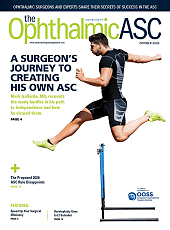In today’s complex and highly regulated health care environment, maintaining compliance in billing, coding, and documentation is essential for every eyecare practice. With increasing scrutiny from the Centers for Medicare and Medicaid Services (CMS) and evolving expectations from payers, practices must adopt a proactive, data-informed approach to compliance efforts to avoid costly errors and ensure accurate reimbursement. One of the most effective strategies in this effort is conducting a utilization analysis (UA), performing regular chart audits, and providing customized training.
Rather than waiting for compliance issues to surface through payer audits or claim denials, practices can use an internal review process to stay ahead of potential issues. By implementing a compliance program that includes a UA and a chart review, eyecare practices can gain essential insight into their own operations and use this information to target improvement efforts and enhance provider education.
Why Utilization Analysis Matters
A UA is a comprehensive review of provider billing patterns over a defined period (typically 12 months). It compares each provider’s billing trends to CMS averages and internal peers. In addition to reducing compliance risk, a well-executed UA can uncover underbilling or missed revenue opportunities. These reviews generally focus on:
- Evaluation and management (E/M) and eye code usage, plus the distribution of new vs established patient visits
- Frequency and appropriateness of diagnostic testing
- Major and minor surgical procedures billed by ophthalmologists (MDs) and optometrists (ODs)
- Use of modifiers, particularly those under heightened scrutiny, such as modifier -24 and modifier -25
- Patterns of undercoding or overutilization, which could signal inconsistent or oversimplified application of coding rules
These data points can help practice leaders identify outliers and evaluate potential risks or missed opportunities. For example, a provider consistently billing high-level E/M codes far more frequently than their peers may have a higher risk for a targeted probe and educate (TPE) audit, as several medicare administrative contractors (MACs) currently have E/M coding on their active TPE lists.1,2,3 Conversely, a provider billing for diagnostic testing well below peer averages may be underutilizing or underbilling for appropriate services.
It’s important to note that being an outlier doesn’t automatically indicate noncompliance or improper billing. Variances can stem from factors such as patient demographics, subspecialty focus, or specific provider roles. Still, uncovering these patterns through a UA offers a valuable starting point for further review, discussion, and targeted training.
Turning Data Into Action
After identifying trends and potential outliers through the UA, practices should take the next step and perform a chart audit. This gives a hands-on review of clinical documentation and coding accuracy. These audits help answer critical questions, such as:
- Does the documentation support the level of service that was billed?
- Are diagnostic tests ordered based on medical necessity and consistent with accepted clinical guidelines or preferred practice patterns?
- Are procedures properly supported by preoperative medical necessity and intraoperative notes?
Chart audits allow practices to move beyond the UA numbers, providing insight into the real-world context of coding and documentation. A chart audit can help determine whether utilization patterns are fully supported with accurate documentation.
Using Targeted Training
The ultimate goal of the UA and chart audit is to assess current performance and build a culture of continuous compliance and education. Armed with insights from the UA and clinical examples from the chart audit, practices can develop customized training that focuses on:
- Appropriate use of E/M and eye codes
- Documentation requirements for diagnostic testing and procedures
- Proper application of modifiers
Training should be tailored, not generic. Providers tend to benefit most when education is focused on the exact issues that surfaced during their review, using real examples when possible. To promote consistency and enhance the overall accuracy of documentation and claim submission, practices should also include the billing team, scribes, and technicians in the training process.
Establishing Best Practices Early
Integrating new providers into compliance efforts early in their tenure is another essential strategy for success. Performing a chart audit for recently hired providers allows practices to detect and address potential discrepancies before they become systemic issues.
New providers may come from different training backgrounds or prior practice environments, with varying documentation and coding expectations. Early feedback and training can help solidify their understanding of the practice’s compliance expectations and payer requirements, setting them up for long-term success.
Long-Term Benefits
When conducted routinely, UA, chart audits, and personalized training foster a culture of transparency, on-going learning, and continuous improvement. To maintain momentum, many practices integrate these activities into their compliance plans every 1 to 2 years, helping them stay aligned with CMS policy changes and specialty-specific coding updates. Establishing a strong compliance framework doesn’t require waiting for issues to emerge. By proactively implementing UA, chart audits, and targeted provider education, eyecare practices can uncover and address risks before they result in compliance issues or revenue loss. Whether the goal is to reduce risk, optimize reimbursement, or onboard new team members, this structured approach provides a powerful foundation for long-term success. OM
References
1. First Coast Service Options. Targeted Probe and Educate Topics and Schedule of Review. Accessed August 19, 2025. https://medicare.fcso.com/medical-review/targeted-probe-and-educate-tpe-topics-and-schedule-review
2. Palmetto GBA JM Parts A, B, Home Health and Hospice Active Medical Review List. Accessed August 19, 2025. https://palmettogba.com/jmb/did/btpod0a22i
3. Novitas Solutions Targeted Probe and Educate (TPE) Topics and Schedule of Review. Accessed August 19, 2025. https://www.novitas-solutions.com/webcenter/portal/MedicareJL/pagebyid?contentId=00184111









